Exploring the Ancient Egyptian Discovery: 30 Mummies Unearthed in 2,000-Year-Old Tomb, Including a Mother and Child
The Egyptian Ministry of Antiquities has announced a major archaeological discovery in the southeast of the country. An international team has discovered 30 Egyptian mummies that are approximately 2,000 years old. The mummies include adults, children and babies and were found in a network of burial chambers. A room filled with items related to ancient burial practices was also brought to light. This discovery is expected to help us better understand Ancient Egypt during a crucial period of change.
The mummies were found by a team of Italian and Egyptian archaeologists working in Aswan, Egypt. This was once an important outpost on the Nubian border and in ancient times it was known as Swenett.

The area where the discovery was made is named after the nearby Aga Khan mausoleum, which houses the remains of an imam revered by the Nizari Ismali sect of Islam.
There are several dozen burial sites, from various periods at this location. Over the past four years, the team at this site has “mapped some 300 graves, 25 of which have been excavated in the last four years,” according to Geek.com.

While investigating a previously unexcavated area, archaeologists found a rock-cut tomb. This burial place was found hidden behind a stone wall and surprisingly had not been discovered by grave robbers. Experts entered and found that it contained a large tomb and several connected burial chambers, one tomb having been dug out of the ground. Other rooms were also located. The experts found a writing indicating that it belonged to an individual named Tjt.

In total, about 30 mummies were found, still wrapped in linen bandages. They included the corpses of men, women and children. According to Newsweek, they found the remains of “children hidden in a hole to the side” of the main grave. In one area, what is believed to be a dead mother with a baby in her arms was found. Four other mummies were also discovered in a structure containing several jars still containing food.
Many items were found in the tomb complex. All the artifacts date from the Hellenistic and Roman period (333 BC to AD 300). This was a time when Greco-Roman influences were fused with native Egyptian culture, to create syncretic religious and funerary practices.

In one room, the team members found evidence that the funeral trade was practiced in the tomb. The experts found a variety of items that were used in the mummification process, such as bitumen and line.
A stretcher made of palm wood and pieces of linen was also found, presumably to carry mummies.
They found a remarkable statuette of a Ba-Bird, which has the body of a bird and a human head. This represented the soul or immaterial being of the deceased.

A funerary workshop in the tomb In the same room they also found a lot of cardboard, material made from strips of cloth, papyrus and layers of plaster. They also found some half-finished funeral masks. It seemed that workers made the cartouche here and turned it into masks and other grave goods, which were hand-painted with brightly colored symbols and designs. The team investigated the many mask and coffin fragments in the tomb complex and provided invaluable information.

The discovery of a series of perfectly preserved burial chambers is an important find. The mummies may offer new insights into burial practices and religious beliefs in the classical period. In addition, the workshop or warehouse is helping us to understand the funerary trade in Ancient Egypt. Many more exciting discoveries are expected to be made in the area of the Aga Khan mausoleum in Aswan.





